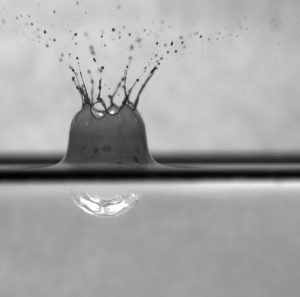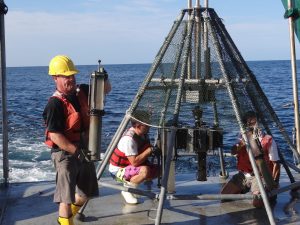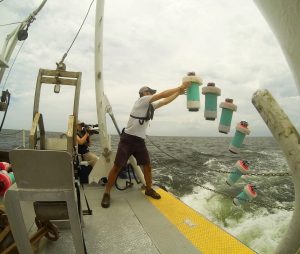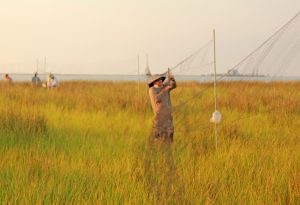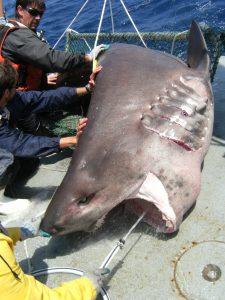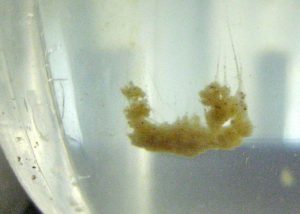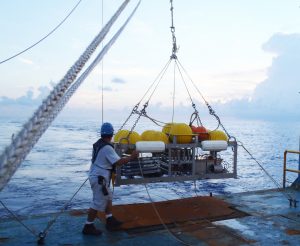GoMRI Advances Science Four Years after Deepwater Horizon Oil Spill
– April 18, 2014
Since August 2011, eight research consortia funded by the Gulf of Mexico Research Initiative (GoMRI) have been working hard to understand impacts from and responses to the Deepwater Horizon incident. Their work represents the efforts of over 1,000 people, including 400 scientists and 275 graduate students, from over 100 national and international institutions.
When asked about accomplishments, the research directors identified progress in areas of the food web, dispersants, marshes, oil fate, and prediction capabilities – all with implications for environmental and public health. These advances contribute to building a better understanding of recovery, damage, and response.
Some of these accomplishments are published in peer-reviewed journals and others are in progress, but offered here because the work in and of itself are advancements. To learn more about the findings mentioned here and many others, see consortia information at the end of this article.
Food Web
Marine microorganisms play critical roles in ecosystems by carrying out many biogeochemical processes, contributing to primary productivity, the regulation of water quality, and the bioremediation of contaminants. Researchers with the Deepsea to Coast Connectivity in the Eastern Gulf of Mexico (Deep-C) consortium used data from time-series studies on oiled beach sands and experimental approaches to understand the effect of oil linked to the Deepwater Horizon on indigenous microbial communities. Their results indicate that the abundance of oil-degrading microbes increased by orders of magnitude in oil-penetrated beach sands, diminishing both the abundance and overall diversity of other microbial species. Once the oil degraded, their populations declined and non-oil-degrading populations increased, indicating resiliency in the system in terms of function with subtle changes in community structure over time.
Microbes also served to transfer carbon derived from methane gas released from the Macondo well upward in the food chain through the action of planktonic organisms. Deep-C researchers, using isotopic tracers, found that methane may have been more effective at finding its way into the food web through planktonic organisms than liquid oil compounds.
Because zooplankton are both consumers and conveyors of toxins floating in water, some studies focus specifically on them. Researchers with the Dispersion Research on Oil: Physics and Plankton Studies (DROPPS) consortium are conducting experiments that relate to the breakup of crude oil treated with chemical dispersants and the interactions of dispersed oil and plankton in the marine environment. Using florescence microscopy and analyzing the fecal pellets of zooplankton, they are finding that zooplankton consumed tiny oil droplets dispersed into the water that fall within the size range of their normal food.
There remains high public concern about the health of marine life in the Gulf, especially the health of economically important species. Over the past two and a half years, GoMRI-funded scientists have conducted several hundred sea expeditions, collecting tens of thousands of biological samples from hundreds of species from the coast to the deep sea. They have used biomarkers, isotopic signatures, and other means of evaluating the presence and bioaccumulation rates of toxins across a wide range of species. Their results indicate both species- and site-specific differences, with toxins returning to pre-spill conditions in some and continuing to accrue in others, indicating continued exposure to contaminants.
Analyses by researchers with Center for Integrated Modeling and Analysis of Gulf Ecosystems (C-IMAGE) consortium are showing that contaminant levels have declined in some fish species such as red snapper while in others such as tilefish, contamination in their internal organs persists at relatively high levels from continuing exposure. Similarly, Deep-C found that in deep-water species, polycyclic aromatic hydrocarbons (PAHs) are largely below detectable levels and where detectable, they differed little from reference site levels. However, they found that some sharks are experiencing continued exposure to low PAH levels, with increased PAHs in tissues, at levels comparable to those in other chronically polluted sites. Additionally, they are continuing to study increased naphthalene levels found in liver bile metabolites, suggesting a redistribution of oil since naphthalene is normally broken down in weathered oil and persists in buried deposits.
Wetlands
Coastal marshes provide critical ecosystem services, from filtering harmful nutrients in water to housing juvenile and adult marine and land animals. Researchers with Coastal Waters Consortium (CWC) are focusing their efforts on the heavily-oiled Louisiana wetlands, which were already ecologically fragile.
CWC established sampling sites in both oiled and non-oiled marsh lands, allowing them to collect time-series data. These return visits are showing that there were multiple oilings in 2010 and in subsequent years as a result of oil residue redistribution throughout the estuary. Analyses of field samples showed Macondo oil in sediments up to 100 meters into the marsh. Their results indicate that decomposition of some oil fractions (alkanes) are on a trajectory to return to baseline levels within five years while others (aromatics) are not projected to do so for several decades.
Despite the multiple oilings, CWC found that the negative impacts were less than anticipated in oysters, mussels and some life stages of fish. However, they are documenting harmful effects on insects, spiders, and Seaside Sparrows living in saltmarshes from the long-lasting aromatic fractions buried in the sediments that vaporize and release toxins when air temperatures rise above 84 degrees Fahrenheit.
Dispersants
Following the blowout, responders used an unprecedented quantity of dispersants on surface oil and a first-time-ever use of them in deep waters at the gushing wellhead site, raising questions of safety and effectiveness. GoMRI-funded researchers are conducting studies to address both of these issues.
With the premise that dispersants will continue to play a role in spill response, researchers with Consortium for the Molecular Engineering of Dispersant Systems (C-MEDS) are working on new classes of green dispersants made from biomolecular materials and naturally occurring inorganic materials. They are making progress using combinations of natural clay minerals and new carbons and with synthetic chemicals such as polymer-based materials. These show promise for new products that adhere strongly to the oil-water interface and stabilize oil droplets, which could prevent the formation of large slicks. C-MEDS is finding that biopolymers derived from cactus mucilage and chitosan can work synergistically with chemical dispersants and may minimize the use of solvents. They are working on new gelation agents that may prevent oil from spreading and impacting coastlines.
Using computer simulations that detail molecular phenomena at the oil-water interface, C-MEDS has advanced understanding of dispersant behavior and effectiveness, such as understanding how fast dispersant components attach at this juncture. Knowing this is essential in determining the frequency, location and amount of dispersant needed.
To understand the impacts of dispersed oil that remained in the water column, researchers with DROPPS are conducting experiments that recreate natural ocean processes and use high-speed digital holographic imagery to capture the evolution of dispersed oil drops. Intended to help biodegradation, surface oil treated with dispersants turn into very small oil droplets; however, DROPPS researchers are finding indications that dispersants may break up the oil into droplets that may be too small (submicron to a few microns) for hydrocarbon-degrading bacteria of similar size to consume them. When exposed to physical forces, ranging from raindrops to breaking waves, these droplets disperse into air and water. The tiny aerosolized droplets have the potential to be carried considerable distances by the wind and may pose a potential health threats to humans and wildlife through inhalation or contact with the skin.
There are ongoing discussions about the effectiveness of and impacts from using dispersants at deep seafloor levels. C-IMAGE is conducting experiments in high-pressure facilities that recreate the conditions at the Macondo wellhead site to determine the accuracy of initial results that indicate the deep plumes of fine oil particles were primarily created by the processes associated with the depth and low temperature conditions and might not be from the addition of dispersants.
Oil Fate
In the months following the blowout, responders were only able to remove a portion of visible oil, and the surface oil they did not capture wound up on coastal shorelines. And to this day, some of the oil that remained beneath the surface continues to wash up on beaches as weathered tar balls and mats. However, according to calculations based on the amount of oil released, there remains concern about the fate of unaccounted oil.
Researchers with Ecosystem Impacts of Oil and Gas Inputs to the Gulf (ECOGIG) consortium, Deep-C, and C-IMAGE – as individual groups and as multi-consortia teams – are finding that a significant quantity of the oil is located in deep and shelf sediments, likely associated with a marine snow event that caused a dramatic increase in sediment accumulation and oiling on the open ocean seafloor. As a collaborative team, they are beginning to builda comprehensive picture of these events during and after the spill, working to understand the processes leading to their formation, sinking and subsequent fate and impact on pelagic and benthic ecosystems. Prior to this, increased sedimentation was not considered as a pathway for oil in past response strategies and is not included in the current oil budget calculator for this oil spill. Efforts are underway to include these processes in models and in future response tools.
To understand the fate of some of that buried Macondo oil, Deep-C compared oil degradation in the shallow sandy shelf sediments with muddy shallow and deeper seabeds. They found that water, moving through the porous sand, introduced oxygen in oiled shelf sediments. The combination of oxygen stimulating bacterial degradation and of the water flowing deep into and through these sands caused small particles of buried oil to re-emerge in overlying water with potentially increased solubility of degraded oil and toxins.
Prediction Capabilities
Some of the most pressing questions that both responders and the public asked during and after the spill were “where is the oil going?” and “how fast will it get there?” Predictions had enormous influence on mobilizing at-sea and shoreline preparedness and clean-up resources. The integration of data from satellite imagery, weather forecasts, oceanic measurements, and more across multiple agencies and institutions is a complex process. And adding to the complexity was an unprecedented event in the much under-studied Gulf of Mexico, leaving a great deal of uncertainty. GoMRI-funded scientists have reduced this uncertainty and improved the coordination, sharing, and output of data.
Improvements to model calculations have come from tracer release experiments conducted by researchers from the Gulf of Mexico Integrated Spill Response (GISR) that provide data on how fast oil can travel beneath the surface. These experiments provided estimates of the horizontal and vertical movement and spreading of an inert liquid at different depths in the water column across the Gulf. The rate of vertical mixing in the deep Gulf was found to be similar to that in other parts of the deep ocean, but near the slope the rate is much faster and they now know how much faster the rate is likely to be. GISR has also included ocean-atmosphere coupling in models of oil slick movement and dispersion. Although this requires large amounts of computing power, they now have a working model at very fine resolution that can be used to drive models of the shelf and bay circulations. This can improve prediction of how future oil spills will spread and provide valuable information to direct where sampling should be done.
Improved model calculations have come from two major observational programs that researchers with Consortium for Advanced Research on Transport of Hydrocarbon in the Environment (CARTHE) conducted, providing data as to how and where oil spreads on surface and just-below surface waters in both open ocean and shoreline areas. The Grand Lagrangian Deployment (GLAD) was the largest upper-ocean dispersion experiment to date. The Surfzone Coastal Oil Pathways Experiment (SCOPE) was an unprecedented simultaneous use of drifters, dye, satellite remote sensing, and targeted upper-ocean measurements. These programs included multiple modeling streams, both in real time and reanalysis modes. These experiments demonstrated that a near-simultaneous launch of large numbers of precision-tracked drifters is the most accurate and cost-effective way to get surface flow information to modelers and responders. It also advanced fundamental understanding of the ocean. Using drifter data, improved models can provide responders with better information, helping them to allocate their limited resources to minimize environmental and public health impacts.
Understanding the Gulf
Together, this body of work provides the scientific community with an improved baseline of Gulf ecosystem status and its response from microbes to higher trophic levels and from deep ocean waters to shoreline marshes. There is information about new species, new associations, and ecological information on poorly known taxa. Work progresses to understand existing dispersants and development of safer, more effective products. A paradigm shift in thinking is evolving about the influence of small scales/features on hydrocarbon dispersion as well as the high vertical flow gradients near the air-sea interface. New data and improved models are advancing accuracy in tracking and predicting oil movement which have applications beyond the oil spill – they can be used for finding objects lost at sea or estimating the movement of biological species such as fish larvae.
In their discussions, the directors also spoke about a different advancement that greatly enhances research and understanding the Gulf of Mexico. They attribute the GoMRI program as a catalyst for developing a collaborative research community – a wide multi-disciplinary network of experienced “ready to go” experts with “speed dial” access to one another – who can address important emerging issues, as displayed in their rapid response to the Hercules gas blowout last summer and their more recent involvement in the Galveston Tanker incident.
The GoMRI science community is excited about the research done, underway, and planned for the next six years and beyond to improve understanding about impacts and response decisions. For specific information about the above and other advancements, contact the consortia directly:
Steven Murawski, University of South Florida College of Marine Science, lead for the Center for Integrated Modeling and Analysis of Gulf Ecosystems (C-IMAGE) consortium. C-IMAGE website
Vijay T. John, Tulane University Department of Chemical and Biomolecular Engineering, lead for the Consortium for the Molecular Engineering of Dispersant Systems (C-MEDS). C-MEDS website
Tamay M. Özgökmen, University of Miami Rosenstiel School of Marine and Atmospheric Science, lead for the Consortium for Advanced Research on Transport of Hydrocarbon in the Environment (CARTHE). CARTHE website
Nancy Rabalais, Louisiana Universities Marine Consortium (LUMCON) DeFelice Marine Center, lead for the Coastal Waters Consortium (CWC). CWC website
Eric P. Chassignet, Florida State University Center for Ocean-Atmospheric Prediction Studies, lead for the Deepsea to Coast Connectivity in the Eastern Gulf of Mexico (Deep-C) consortium. Deep-C website
Edward J. Buskey, The University of Texas at Austin Department of Marine Science, lead for the Dispersion Research on Oil: Physics and Plankton Studies (DROPPS) consortium. DROPPS website
Charles Geoffrey Wheat, University of Mississippi, lead for the Ecosystem Impacts of Oil and Gas Inputs to the Gulf (ECOGIG) consortium. ECOGIG website
Piers Chapman, Texas A&M University Department of Oceanography, lead for the Gulf of Mexico Integrated Spill Response (GISR) consortium.
***********
This research was made possible by grants from BP/The Gulf of Mexico Research Initiative (GoMRI). The GoMRI is a 10-year independent research program established to study the effect, and the potential associated impact, of hydrocarbon releases on the environment and public health, as well as to develop improved spill mitigation, oil detection, characterization and remediation technologies. An independent and academic 20-member Research Board makes the funding and research direction decisions to ensure the intellectual quality, effectiveness and academic independence of the GoMRI research. All research data, findings and publications will be made publicly available. The program was established through a $500 million financial commitment from BP. For more information, visit https://gulfresearchinitiative.org/.
© Copyright 2010-2017 Gulf of Mexico Research Initiative (GoMRI) – All Rights Reserved. Redistribution is encouraged with acknowledgement to the Gulf of Mexico Research Initiative (GoMRI). Please credit images and/or videos as done in each article. Questions? Contact web-content editor Nilde “Maggie” Dannreuther, Northern Gulf Institute, Mississippi State University (maggied@ngi.msstate.edu).

